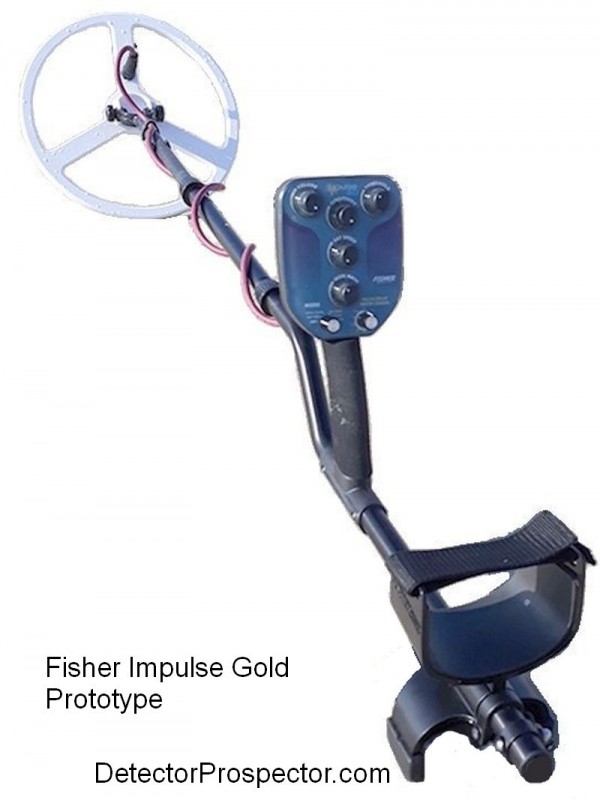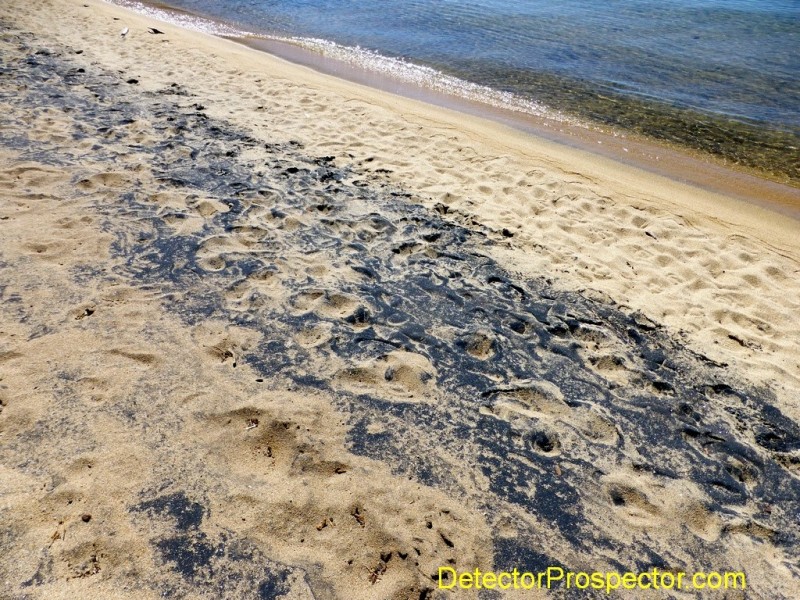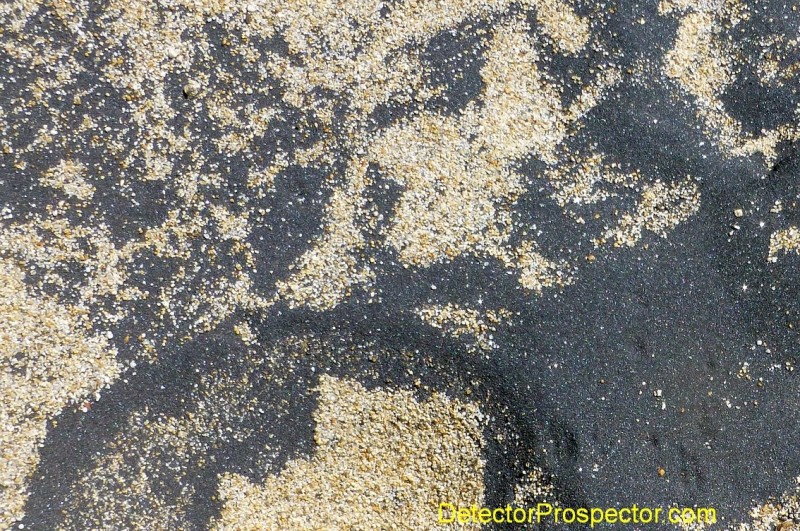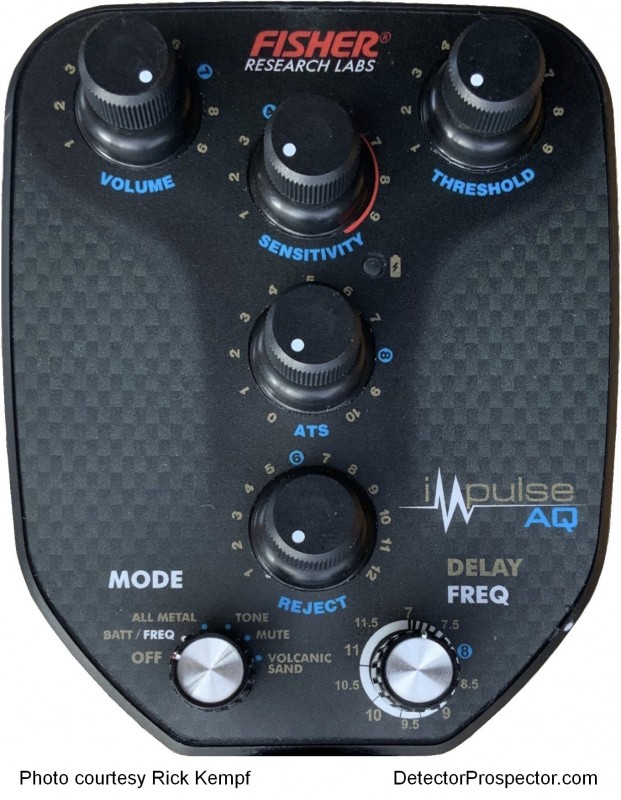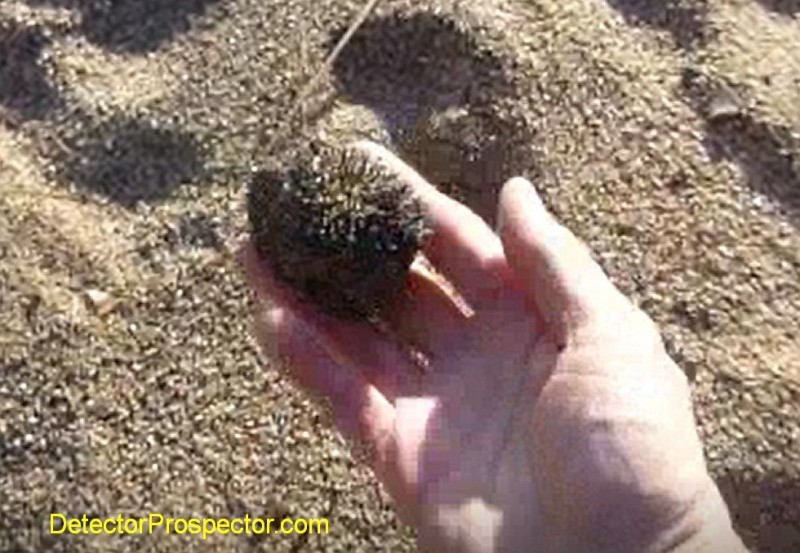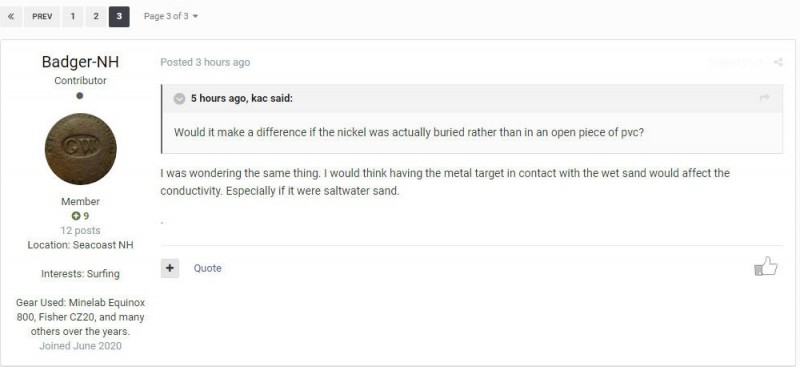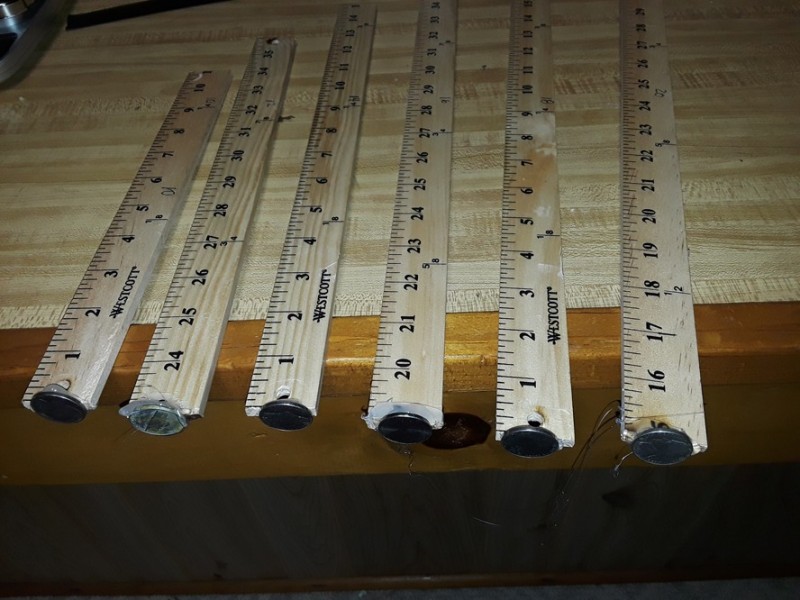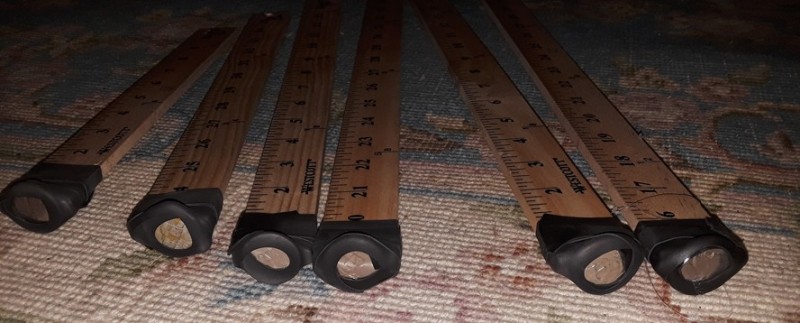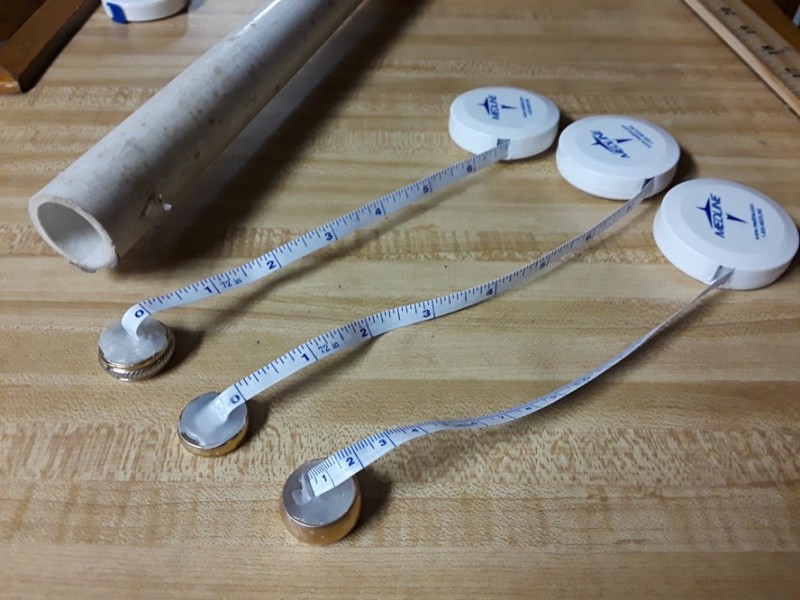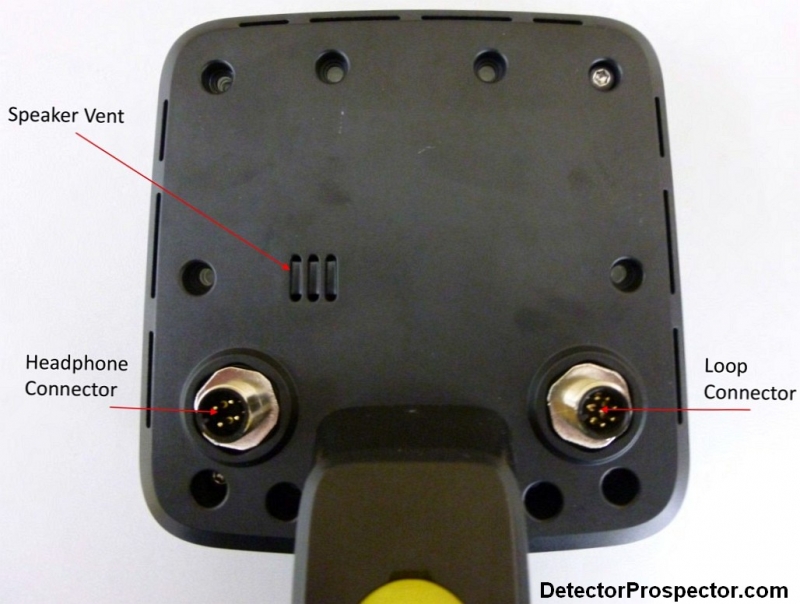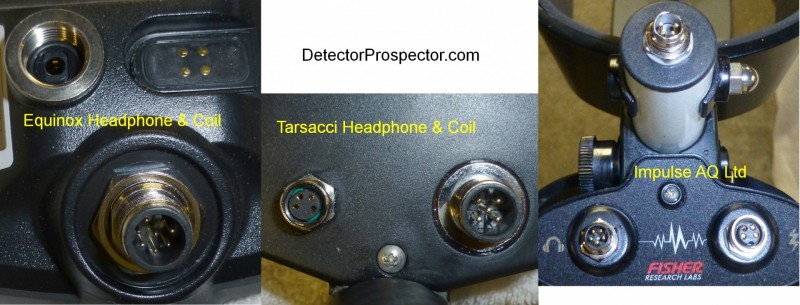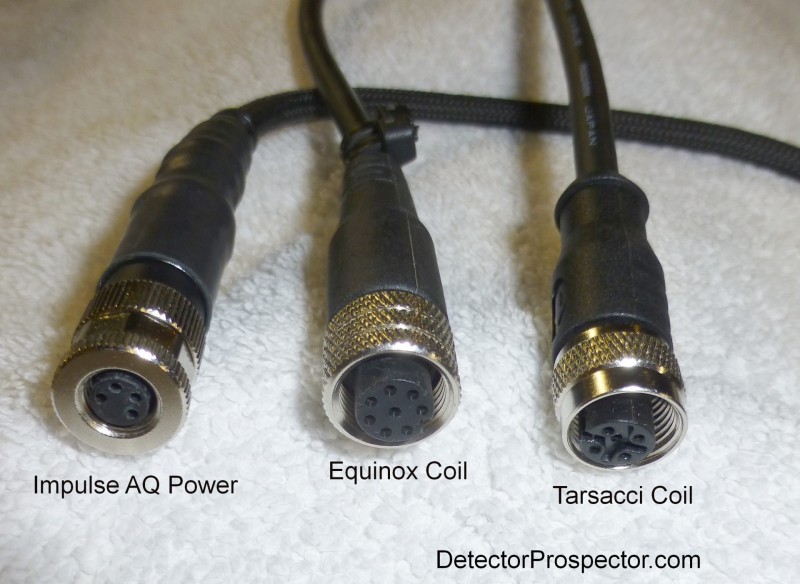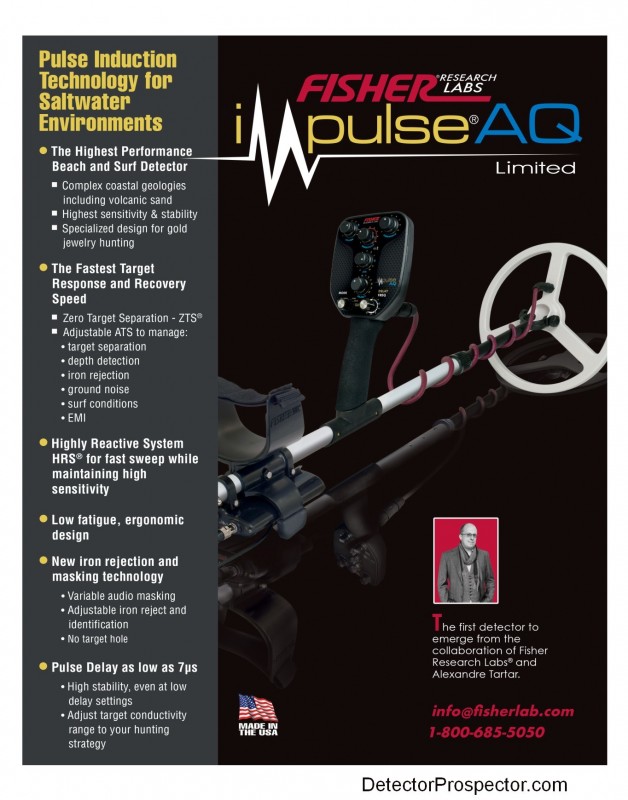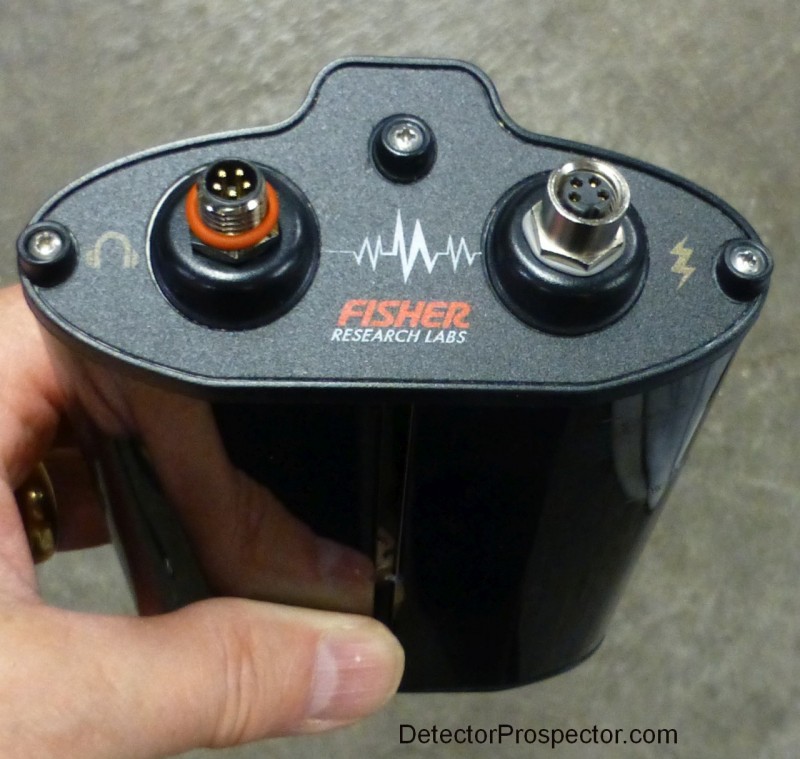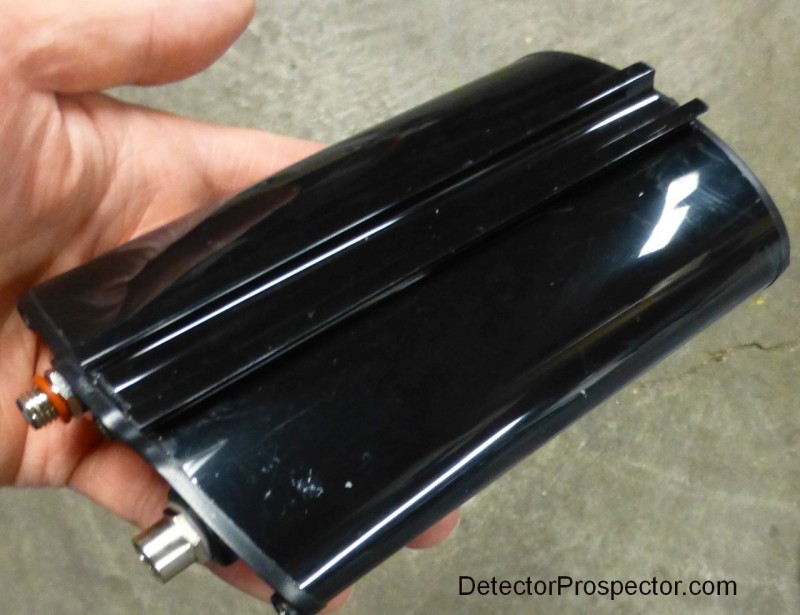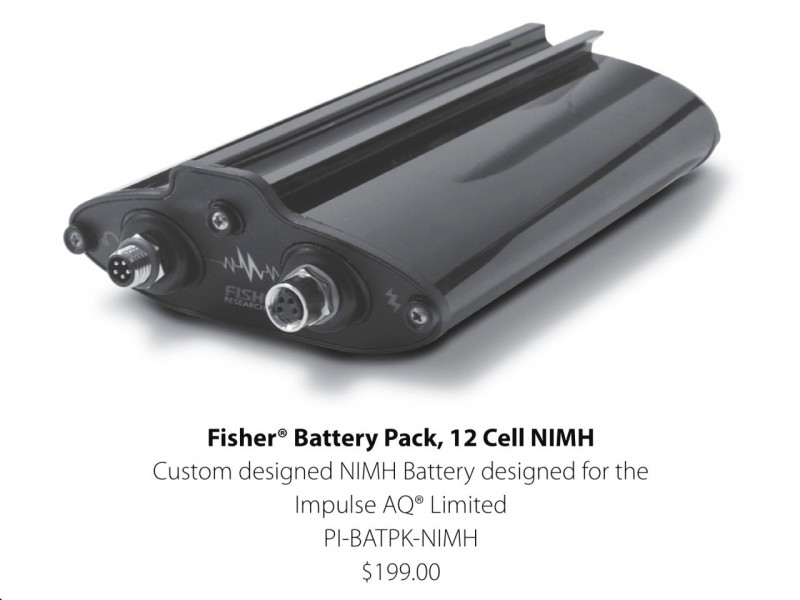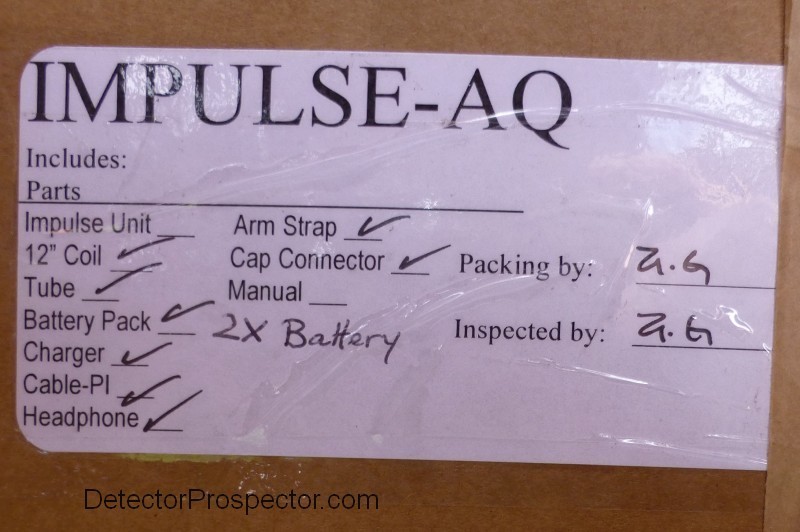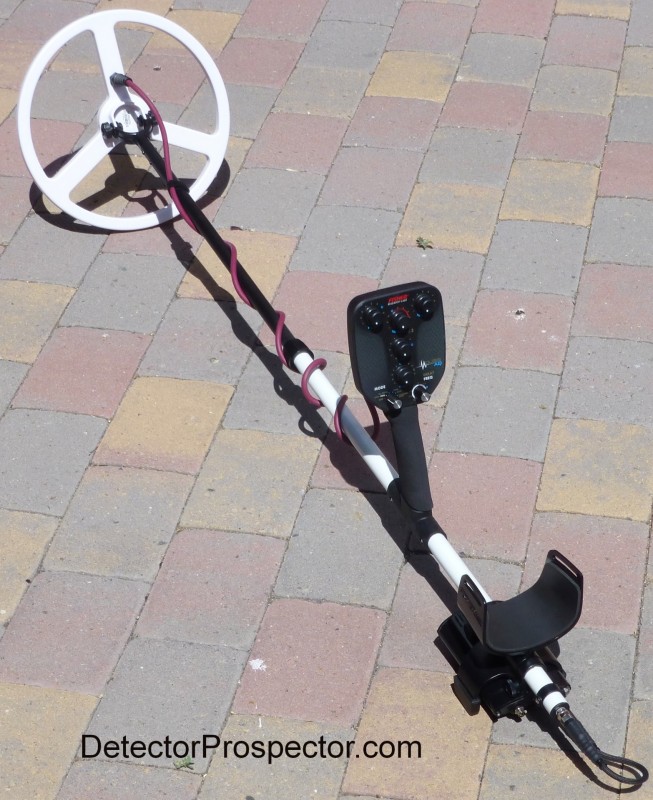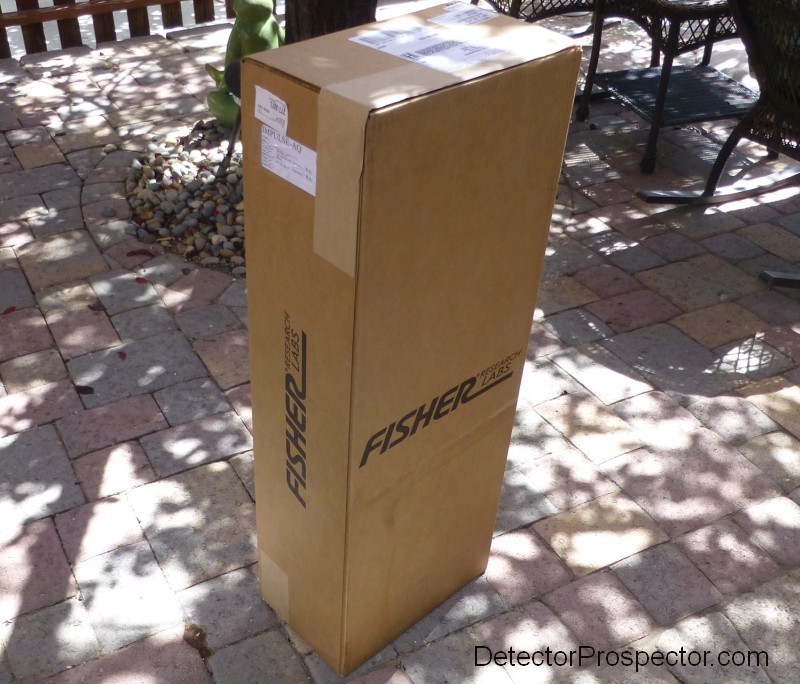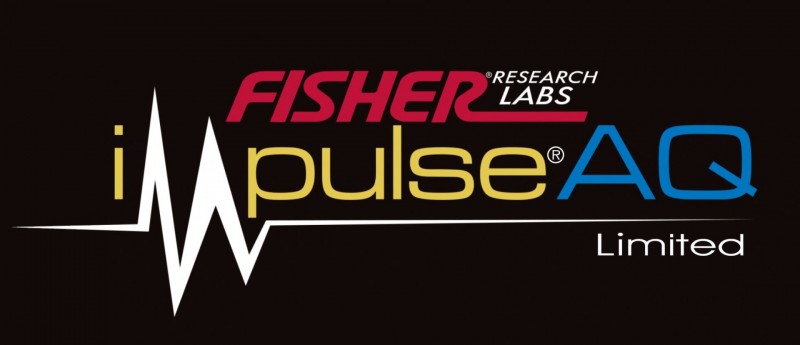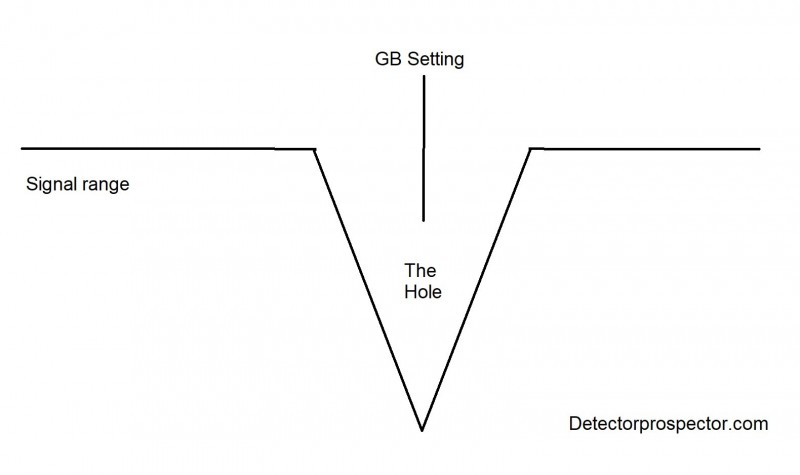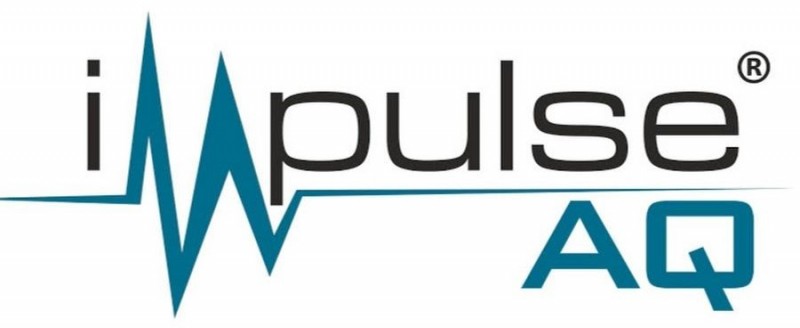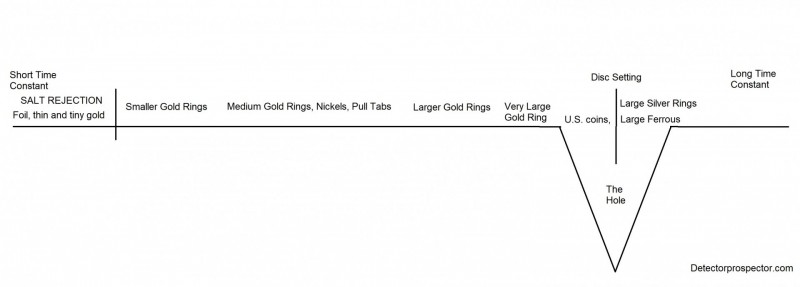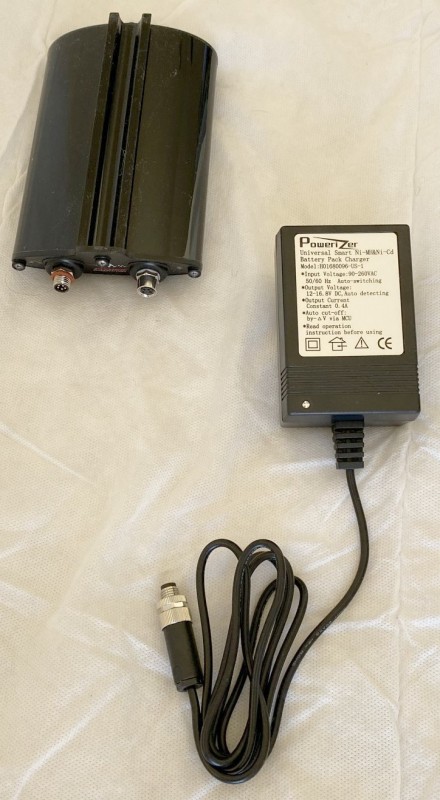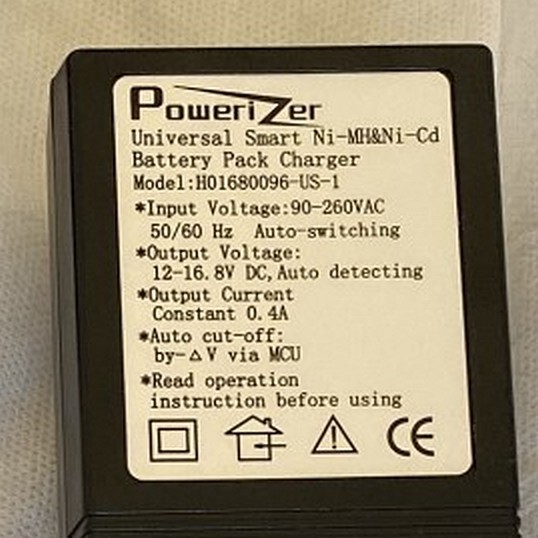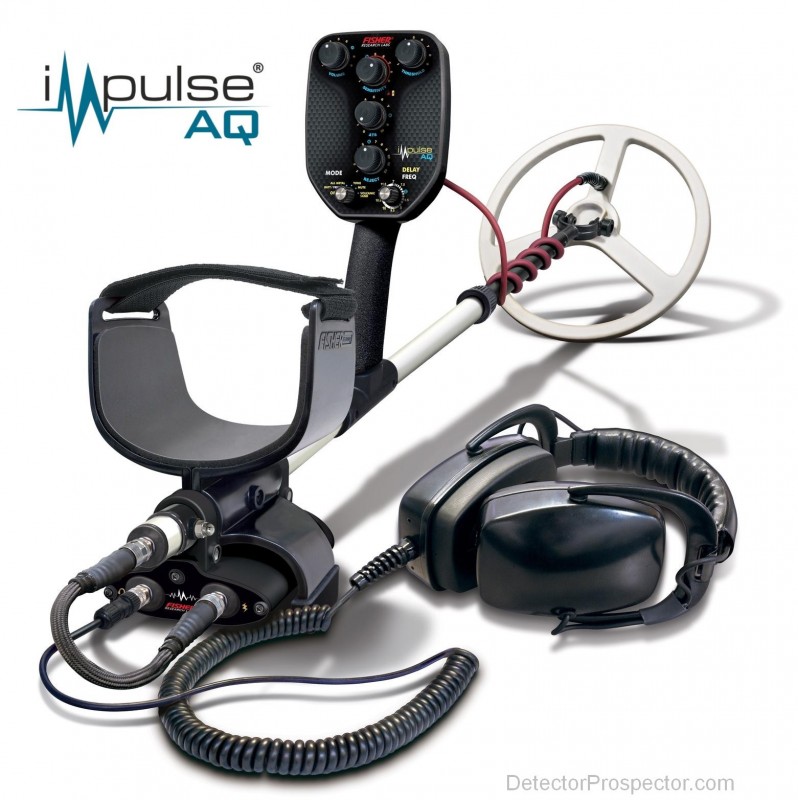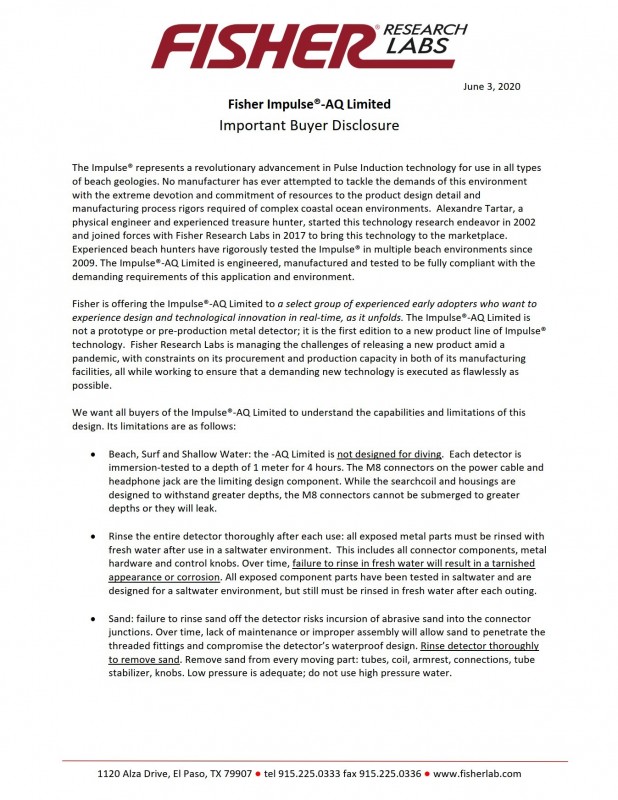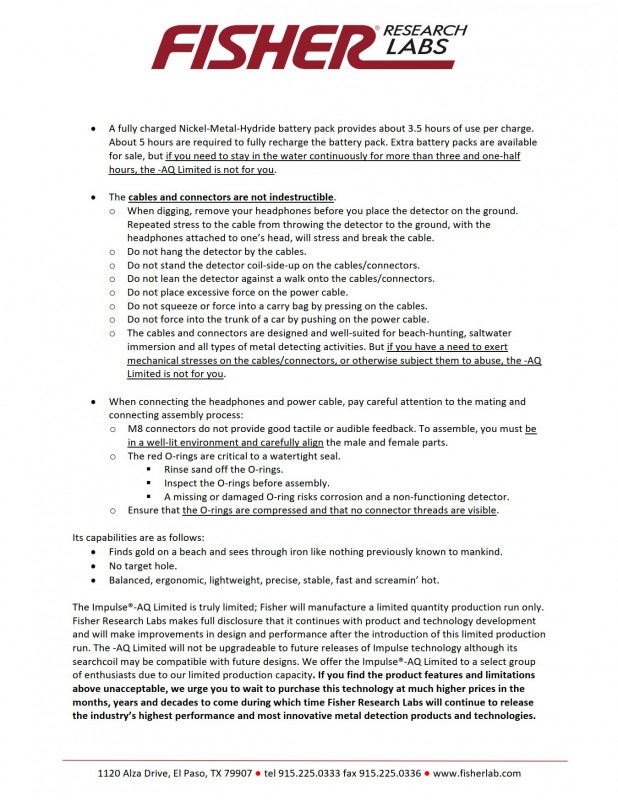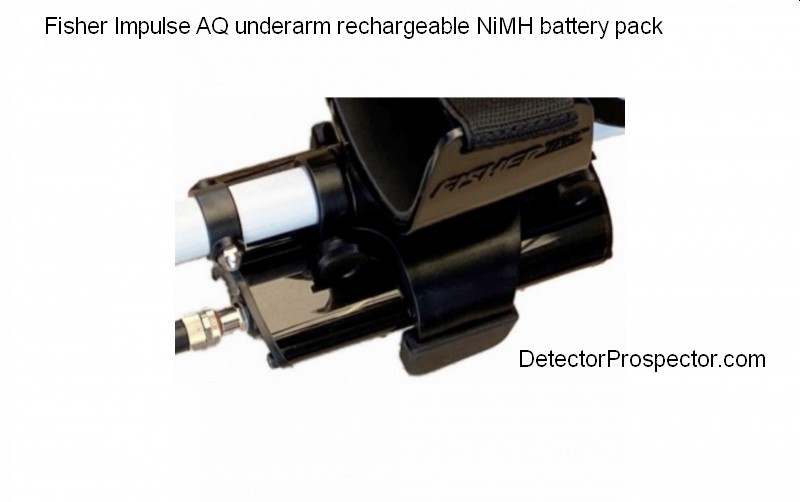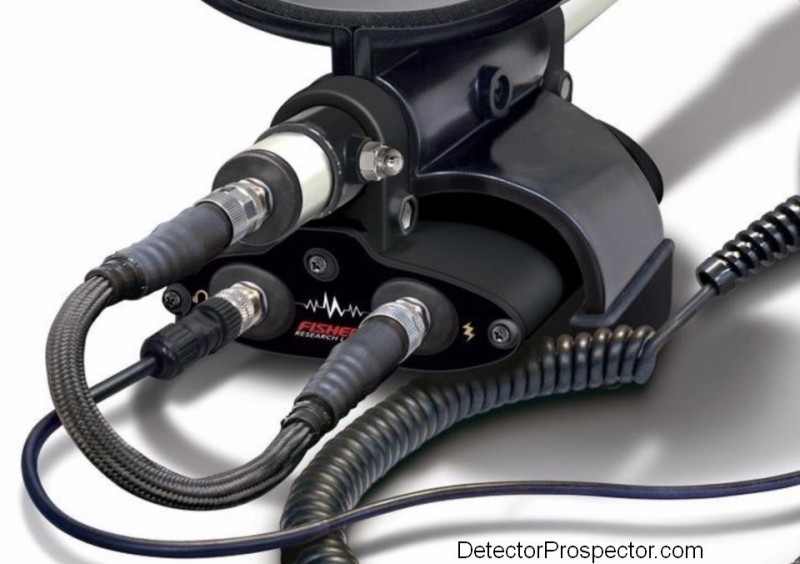Search the Community
Showing results for tags 'fisher impulse'.
-
Note from Steve H - I made a comment on my first use of the Fisher Impulse AQ that the rod was a little too short - FOR ME. That has been picked up on to mean I am saying the rod is too short, and well, how could they? I don't think so, same rod as has been used on 1280-x and CZ-20 etc for like 40 years. I am just very particular in rod length and positioning, and 1/4” off will bug me. The stock rod is an inch too short for my liking is all, but I like a long reach and sweep if I so desire it. I am 5' 11" tall. See my post later on down this thread for measurements with photos, and you can decide for yourself. The main thing is the rod is two piece, and that limits the adjustment. The original Manta rod was three piece, but it was metal and prone to corrosion, so they went to the CZ fiberglass rod instead. This is Badgers original post, moved from another thread: I guess they weren't kidding when they said the connectors were fragile. Too bad the stock shaft is so short. I'm six feet tall and it sounds like the LTD would be way too short for me without that middle rod.
-
OK, my first outing had me ready to get serious. I was quite satisfied with the performance of the Impulse AQ. I found I needed to extend the rod for more reach, and was fortunate enough to have a Fisher middle rod section for a Gold Bug 2 at home, so I added that for more length. Now the shortest setting is almost too long, but for me perfect, and room for more extension. (New rod length thread here) I also decided I needed a way to suspend the AQ by my side while I was digging, so I used a short piece of parachute cord from my wader suspenders to just below the handle tied off just right. So the AQ hangs just below waist height if released. Up at 6am to be at the beach for 8am opening to get in a full day, two fully charged batteries ready to go. Weather looking perfect, sunny and not too warm for wader work. I had decided that the AQ performance was such that I was going to use tones exclusively and my best cherry picking skills to avoid surface wire and small items, and concentrate on ring type signals. I expected nickels, corroded zinc, pull tabs.... and hopefully a ring or two. Jewelry is sparse at Tahoe but it is there, and I felt confident I now had a depth edge that was going to help find them. All geared up, gave all the fittings one last check to make sure they were good.... and noticed the power cable to battery connection seemed to have some excess wiggle. The normal hairline gap in the fitting seemed a bit off. I pulled on the cable gently, and it pulled right out of the connector! The internal plastic sleeve was broken, and when I got home I fished the other half out of the battery connector with fine point tweezers. All I can say is 3.5 hours total use, I've been paranoid treating this fitting with kid gloves, and it has never even been underwater. If I broke it I have no clue how I did it. The plastic is broken off inside in a way that I am having a hard time seeing how it could even occur. Don't know, it is broke, and I'm done. I wish now when I put the pressure on to get a spare battery I had thought to buy a spare power cable also. Rookie mistake. Duh. Oh well, the water looked perfect, and I got a nice two hour drive. And that is that folks until I get another power cord, and hopefully a spare. Not upset about it, stuff happens, and if anything really do blame myself for not getting a spare. I never went anywhere with my Minelab PI detectors without a spare power cord. Why would I think of doing it with this machine? And the price to be paid sometimes for being the first kid on the block with a new toy. I'm glad I caught it before submerging the machine, though the chance of actual damage occurring in freshwater is almost non-existent, which is one reason I'm just fine keeping this detector out of saltwater for now. Would have been better yet if it had revealed itself on the last trip, which was kind of what the shakeout tour was for. Oh well. Lesson learned for all - get a spare power cable!!!! I have no idea what they cost but will find out and pass it on. We need a part number and price so people can buy spares. I expect a replacement under warranty, but I am more than happy to pay for a spare. Would have saved me a bit of gas money if nothing else this morning and...... the water looked so good!
-
Near the end I call the 10.8 gram gold ring 14 grams but it is 14k... Next week coming I should have more Video's , winds and water have been bad all this week. When sharing video's I like the audio to be as clean as possible so those watching can get a better idea of what to expect...since I feel the audio is very important. I will be headed back to the two beach's I'm focusing on for right now. Both cove beach's, up rivers with calm waters. Very excited that I can get back to these two spots and even find good targets...So more to come on those.
-
I was wondering what features in the new Impulse Gold detector you nugget detectorists would like to see in this new machine to make you buy? For myself the lightweight part is very important, I would also like to see solid coils for ease of use in uneven terrain, and I would like to see gpz type performance on surface grain size gold and would like to see gpz type performance on 1-2 gram nuggets at depth. Not real concerned about deep large nuggets. Auto ground balance would be a huge plus too. Perhaps the 7 usec timing will be enough to produce gpz type performance on grain size and gram size gold. Time will tell I guess. I don't expect Minelab will be sitting still with regards building a lightweight nugget detector flagship model, sooner than later probably.
-
At some beaches I hunt,in the water(salt) at some places my sea hunter get signals on big rocks (I assume it is magnetic rocks?) and when I dig a scoop I realize it is a big stone.It becomes a lot of time wasting.Just wonder hoe AQ react in these situations?
-
Short answer, the Impulse AQ is the real deal. Advice to Tom Walsh - put all resources necessary into getting the full retail version approved for sale ASAP. I will not be hunting saltwater with the Impulse in the near future but instead local freshwater lakes. The coast is farther than I want to drive for now. Lake Tahoe is a freshwater lake, with beaches made up from material derived from granitic rock. It is a very large lake, with 72 miles of shoreline. Most beaches are pebble beaches. Sand Harbor is a one of the rare sandy beaches on the lake. The sand is heavily laced with magnetite that will greatly inhibit or overload and shut down most VLF detectors. Metamorphic and volcanic hot rocks are also fairly common on the lake. https://www.earthmagazine.org/article/travels-geology-lake-tahoe-jewel-sierra-nevada Black sand (magnetite) layers exposed on beach Closeup of magnetite black sand. Note dark gun metal granular nature of the sand. Highly magnetic. This is a magnet that has been dropped onto the sand and picked back up - a golf ball size lump of magnetite. Most of the soils in my area have a high magnetic component, and most VLF detectors get roughly 60% of the depth normally quoted on most U.S. forums. A ten inch dime here is a bit of a joke... more like 5-6 inches. This beach is particularly bad, and will send the Equinox into almost continuous Beach overload mode. Other modes have to have sensitivity drastically reduced or the machine basically shuts down. Despite this beach having thick magnetite concentrations I had no problem running the machine at 7 uS pulse delay, full sensitivity. I used the default marked settings for other controls. The detector is extremely stable, with rock solid audio. This machine will have me digging as deep as I care to dig. I've almost bit on a TDI Beachhunter a couple times in the last year, and am glad now I did not. This is the detector White's could have made if they had not basically stopped trying to advance the TDI in a meaningful way. There is only one thing about this machine I did not like to the point of needing to do something about it. At 5' 11" the two piece rod is too short for my liking, like by a couple inches. I had to keep the coil a foot ahead of my feet and was still bent over. Thankfully I just found that the middle section out of a standard Fisher three piece rod (I have one in my pile of stuff) plugs nicely into the gap, and will give me that extra reach I need. The power cable sticking out of the back makes it difficult to find a way to prop the detector against my side or hip without stressing the cable while digging. I need to rig a bungee so I can just let it hang by my side while digging. The coil is not as heavy as it looks, and swings quite nicely above the water. Swinging the 12.5" coil underwater however is a bit like swinging through molasses. I'm fine with it but may be a bit much for some, especially in running water. The coil is just ever so slightly buoyant. Not so much as you notice it while swinging - it feels neutral. But if released sitting in the water the coil slowly floats to the surface. It would take only a very small amount of counterweight to make it negative instead of positive buoyant. The coil has no scuff cover, just an exposed epoxy bottom. No word yet on when scuff covers will be available. I like the headphones, very familiar feel to many I've used gold nugget detecting. Snug fit, maybe too snug for some people but good for my not huge head. Good sound exclusion, and plenty of volume for above water use. As in I was running volume 3-4, but I do keep volume low to protect my hearing. How well they work underwater I am unsure but I suspect as well or better than most competitors. The cable has plenty of length, but is not particularly robust looking, and I will probably tie it off on the armrest or someplace to keep from stressing the cable too much near the plug. This detectors Achilles Heel should not surprise PI users - wire and bottle caps. Forget videos seeing rings while rejecting nails... not a ton of nails on most beaches. Show me a video of a ring buried in sand surrounded by hair pins and wire tie wraps plus a few bottle caps. Yup, it's still a PI. That said, anyone who is a PI hunter and likes PI detecting... I think you will like this detector. I'm thrilled with it. Tons of stable power. It will probably need to be dialed back on pulse delay or sensitivity or both in salt water, but once set just under whatever salt threshold is required this machine will deliver the goods. The audio is great. I easily found myself able to start cherry picking deeper "round" signals. The reject setting is most effective as a way to not waste time on dimes or quarters and some large ferrous. The wire and hairpins tend to be shallow and sharp, the deep targets easily discerned with a more centered, marginally softer signal. The coil has the classic double blip on shallow targets as they pass under each edge. This edge coil sensitivity is extremely important. Not only does it quickly identify small surface targets, but it is a great aid in pinpointing. Get the target out of the hole and turn he coil on edge, and quickly locate the item in a pile of sand. Those surface targets are also quickly isolated for a quick scoop and recovery. Fisher Impulse AQ Limited controls The default reject breaks at shiny clean copper coated zinc pennies. They and dimes, quarters, and I assume copper pennies read low tone. Nickels and corroded zinc pennies (ate through the copper) read high tone good, as they should. So the default break is between new clean zinc pennies (low tone) and corroded zinc pennies (high tone). Side note: digging low tones in a park for coins may be fun to try. The Reject control surprisingly seems to have less impact on disc results than the ATS control. ATS at zero basically means no disc no matter where the reject setting is. At the default reject setting of 6 corroded zinc reads good, and advancing the control to max changes nothing. But advancing the ATS control from default 8 to 8.5 flips the corroded zinc to a low tone. And also my gold wedding ring. I left the ATS and Reject at defaults (see photo) as they seemed best... as they should be. The Tone setting does not appear to cost much depth - the 10% quoted by Alexandre seems to be in the ballpark. You can hunt all metal and use a couple tricks. First, you can switch to Tone to check for the coins listed above or large ferrous. Second, if you are dealing with foil, the Pulse Delay control rotates continuously, so you can switch right from 7 uS to 11.5 uS. Foils drops out a lot more than rings, but so will small gold items. Still, a handy thing if you are looking for rings. But I thought running in Tone mode directly was a pretty fine way to go for what I was doing. The machine does not lack for depth even when you give a little up. The Fisher Impulse AQ is made to find rings. I actually am very impressed with the small item capability on dry sand or in freshwater... it will hit tiny stuff just fine and I think finding gold nuggets will not be too much of a challenge with the AQ. But it is really made as a ring finder. I am certain I can cherry pick ring signals with this machine. I found no rings, but dug nickels and corroded zinc at depth and with audio that was easy to discern to my admittedly trained PI ear. I messed with quite a few shallow targets just to confirm most were wire and hairpins. Usually a sharp signal under each edge of the coil. Well, folks, as I suspected it is not a magic wand. However, this PI guy is extremely pleased with this detector. Basically I just have to extend the rod, rig a bungee so I can drop the detector without it hitting the ground, and I'm good to go. I actually like hunting in tones... it adds more audio tells and I really do not mind passing on a lot of coins. I'll worry about maximizing depth later when I run out of beaches and targets. Mainly I need to get my eyes healed up to where I can really deal with water more effectively. Right now shallow wading and cherry picking will suit me just fine. That's most of it. I'm not going to take time to do any proving of anything. Those of you who know me or who have followed my posts for a couple decades know I'm not a BSer. There is not one review I have done in the last twenty-five years I think was off base or that I would change, and they are all still out there to prove it. If you are a serious PI hunter you are probably going to want one of these, though most people are going to want the improved battery/deeper depth rating version. I'm sure I'll be in line for one of the first when they are available. All you folks who have never used a PI and expecting a PI with VLF type discrimination? Well no, this is a PI and it is just a whole different ballgame. You get these things for depth, and most especially depth in difficult conditions where VLFs lose a lot of depth. “Deeper“ is a one dimensional way of looking at metal detecting. My goal is to be more efficient and to locate more “good” targets per hour of metal detecting. The Fisher Impulse AQ offers great ergonomics, superb audio, an advanced discrimination system (for a PI), allowing focus on ring type targets, and as much power as the hunting environment will allow. It’s not just “more depth”, though the AQ has as much as is possible, but the total package that matters to me. When it comes to the total package, including depth, the Impulse AQ delivers. 👍🏼 All Fisher needs to do now is get the full retail version, with improved batteries and depth rating, on the market so people anywhere can buy one. I hope that happens by the end of the year. Sand Harbor by noon - social distancing at its finest!
-
Thanks for the Question Kac and Badger... I had done 3 different test on Nickels at 3 different beach's, ( two of the test were with nickels on the end of yard sticks, then one was dropping the nickel down the PVC pipe) results were 17 plus which is the one in the video below, next test I buried the 18 inch yard stick nickel and it hit fine, then the PVC pipe nickel test which hit at 19-20...The beach in the video below I chose for it had lite veins of black sand in the mix..if you look you can see some behind my scoop. The "AQ" had no problem here hitting the target at 17...the reason I chose 17 inch's...Rick had posted he had got 17 inch's on his beach trips, kind of figure 17 was the limit...I was wrong, it hit good so I went to 18 inch's next trip out.....it hit that good so the PVC pipe kind of gave me more range and easier. Alex Tartar seen the PVC pipe video with the nickel and said your going to need a longer piece of pipe...he was right...but I'm not sure if I can dig a hole 24 inch's deep ...☠️
-
I have seen people question why the waterproof rating of the Fisher Impulse AQ Limited is only 3 feet if it uses the same connectors as the Minelab Equinox. Well, it does not. The Tarsacci uses a mix of connectors, and has the same M8 size headphone connector as the Impulse, but 4 pin instead of 5 pin. The Tarsacci coil connection is larger, same size as used on Equinox and MX Sport. The Tarsacci is rated IP68 (Up to 1.5 meters for up to 30 minutes). That's it, thirty minutes. So the Tarsacci is really only a shallow wading machine also. The Equinox has no M8 connnectors but instead a pain in the butt proprietary headphone connector. Now maybe we know why. The Impulse power connector on the battery is the same 4 pin connection Tarsacci uses for headphones. The Impulse headphone connection is 5 pin. Go figure. The White's MX Sport / GMX connectors are very similar to the Equinox, coil identical, headphone 4 pin. The White’s connectors look like the best of the bunch in my opinion. Looks like what Fisher should have used instead of the smaller connectors. To sum up, Impulse AQ Limited power and headphone plus Tarsacci headphone only are M8. All others are M12. Click or double click for high resolution photos.... Impulse AQ Ltd power compared to Equinox and Tarsacci coil Detector connections, Equinox, Tarsacci, & Impulse AQ Limited White's MX Sport connectors
- 3 replies
-
- minelab equinox
- tarsacci
-
(and 1 more)
Tagged with:
-
Did several test for myself to see what the AQ can do..Air Test , and In the sand. Learning what the machine is capable of is a great advantage when hunting. Like the nickel test I went to 3 different beach's to see how different each beach was and how depth was affected...3 different test, 3 different results. All excellent ...17+...18....19/20 plus. Very consistent in depth. I found on all of those test if your a threshold hunter and hunt slow a few more inch's can be added to the depth. Even on the gold there was a noticeable change ........... where you hear the change...stop, take a scoop to check ..the signal is stronger you dig......
-
Wow! That's my first impression. Wow! It showed up today in a large box. The detector is fully assembled, simply broke into two halves in the box and packaged up well with headphones separate. That ends up making for a large box, about three feet tall. Only things missing is an owners manual (not ready yet) and a coil scuff cover (don't know if there is one). Fisher Impulse AQ Limited arrived in box The label on the side - I paid for an extra battery People, I am used to using machines like the GPZ 7000 and Garrett ATX or GPX 5000, or SDC 2300. This detector by comparison is like holding an F75, light weight, and perfectly balanced. The grip is really nice. Love at first sight and especially first heft! Steve Herschbach Fisher Impulse AQ Limited Quick first impressions. The coil is much lighter than I thought it would be looking at it. It has that heavy epoxy look in pictures, but it is lighter and smaller in real life than I was anticipating. I'll have no problem with this in the water - I've run a CTX 3030 with 17" coil for full days at neck depths. This will be a piece of cake by comparison, especially as regards water resistance. The coil cable is far more supple than I thought it would be. Looks very stiff in the pics, but is very flexible in real life. The over-sized plastic connector to the back of the pod is unique, never seen one like that before, but clicks nicely into place. The power cable is smaller and more supple also than I thought it would be. I'm just too used to huge detectors. This thing - 4 lbs 5.3 ounces on my postal scale. Performance will wait, but this detector looks and feels great. Once the battery and cable gets the do-over, this will be a real home run. But as is, very finished in feel and appearance. Well done, could not be happier at this point. Plan is to go up to Tahoe on Monday for the inaugural run. I have no plans to run to the coast any time soon so those wanting saltwater answers should not be looking to me for them. Maybe someday. If you have other questions, ask on the forum. There is nothing I will say privately that is any different than what I will say publicly. I have no secrets, and sending me a PM or an email will get a "post the question on the forum" response. I'll warn you all right now though that I got this detector to go detecting, so wish lists for tests and videos and whatever... we will see. My plan is basically go do my thing and share any thoughts I have; job one for me is go detecting!
-
I have seen it said a few times now that the new Fisher Impulse AQ has "no holes". This started as a very specific mention on the part of the designer, and now has been expanded into a range of assumptions that do not match how I view the subject. First, what is a "hole?" The classic definition originated around ground balancing pulse induction metal detectors. The first and most simple ground balance method is a basic subtraction. Determine where the ground is reading with the detector, then provide a control to subtract that signal. Many people do not realize that ground signals and gold nugget signals within normal range are basically infinite and overlap 100%. This is due to the nature of natural gold nuggets, which occur in endless variety as far as size, shape, and composition. When added to the ground, they mix and blend with the ground signal, and in one way can be considered a naturally occurring component of a ground signal. There is one simple rule you must keep in mind that makes all discussions of a "hole" simple. For every potential ground signal that exists, there is also a corresponding gold signal. The ground balance control is just a special discrimination control. When you eliminate any one type of ground signal or hot rock, you automatically eliminate any gold signals that are identical to those ground and hot rock signals. The nature of the electronics involved is not 100% in that the ground balance rejection point is not perfectly sharp edged, but covers a small range. Within this rejected ground range, you have the most intense rejection effect at the setting itself. However, items that fall close to the setting, while not eliminated, are weakened, and deliver less than normal depth. The effect is similar to that seen when black holes are diagrammed, and targets that are unintentionally eliminated because they fall into this range are said to "fall into the hole." The classic metal detector ground balance "hole" This can also be seen with many VLF detectors. Take a detector with a manual ground balance control, and grab a coin. Air test the coin depth, while running the ground balance control to both extremes. Depending on the coin or target you test, like a gold ring, you will usually find that the depth varies with the ground balance setting. On a simple ground balance detector with a single ground balance "channel" the effect is quite pronounced. On the White's TDI the ground balance setting is normally around 8. This also corresponds with nuggets weighing approximately 1/4 ounce, though again, because of the natural variation of gold nuggets, the range is actually very large, and based on the time constant of the nugget, not any particular weight. Any nugget that reads at the setting of 8 is essentially eliminated. Nuggets that fall near to the setting have greatly weakened responses. Minelab first addressed this issue with detectors that have two ground balance "channels". Channels have historically referred to detectors that have two separate ground balance "channels" but people are now misusing the term to refer to detectors that are returning dual audio results that can be separated into "channels." This is not the same thing. A dual channel PI has two ground balance sample points that are being compared. The Minelab SD 2100 has a switch that lets one chose one or the other or both ground balance channels. One favors long time constant targets (large nuggets) and the other short time constant targets (small nuggets). The ground result is roughly the same on either channel. By comparing and combining results from the two channels, emphasizing the one with the strongest nugget signal, the "hole" is largely eliminated. This was the major advance and secret to Minelab PI MPS "multi-period sensing" detector technology. The "timings" developed over time were progressively sophisticated comparisons of multiple channel results intended to address specific ground and hot rock situations. No matter what though, the hole never goes away entirely. If you eliminate a certain hot rock, you lose gold that reads like that hot rock. People who set for and are willing to dig what others consider ground and hot rock noises, find targets with PI detectors that others miss. It's one of the secrets of the pros. At a minimum, on Minelab detectors, hunting with a different timing will reveal gold missed with another timing. To sum up, a hole in metal detector terms is what occurs when a good item is unintentionally rejected when some undesired item is rejected or discriminated. This usually refers to good items lost due to the ground balance setting, but can include any items accidentally rejected due to a detector eliminating some undesired target or range of targets. And that brings us to the new Fisher Impulse AQ and the claim of "no holes." As in all marketing claims, yes.... and no. Alexandre Tartar has be quite firm since day one in emphasizing that the AQ is specifically designed to find gold ring range targets to the exclusion of everything else. In his early writings he says that the AQ does focus on this range, and that in that defined gold ring range there are no holes. This is true. Unfortunately that statement has been extrapolated beyond the original intent. It all depends on how you want to define things. I am going with the definition above "a hole in metal detector terms is what occurs when a good item is unintentionally rejected when some undesired item is rejected or discriminated." Under that definition the Impulse AQ has two holes. They have simply been redefined as not being holes, but being something else. The ground balance control has been hijacked on the AQ and is employed as a discrimination control. Instead of being set to reject a certain ground signal, it is being used to reject a certain target range, specifically many ferrous targets. In the process, most U.S. coins except nickels are also rejected. So we have called the ground balance a disc control, and are attempting to eliminate ferrous items. The unintentional side effect is that many high conductors including most U.S. coins are rejected. Note that if this setting is high enough, heavy large gold rings can be eliminated. The ground balance hole is there, and in a big way. We are going to define it out of existence however by calling it a discrimination control. The Volcanic Mode, by eliminating intense beach mineralization, will have an adverse effect on most targets. It has to. You can't eliminate a ground signal that severe without an unintended adverse effect. The Impulse AQ is also locked into salt rejection mode at all times, even in "all metal" mode. Well, almost all metal mode - I wish there was a switch to shut off the salt rejection. There is still a filter engaged, so this is not a pure pulse mode. The machine is always set to eliminate salt signal. This means that small gold items like thin gold chains, small ear rings, aluminum foil, and small gold nuggets, are also going to be unintentionally eliminated. You catching the drift here? Unintended side effects, trade offs deemed necessary to get a desired end deemed more important. Welcome to metal detecting. So we have another hole in the extreme low end, but we have redefined it as being a preset salt rejection mode. So does the Fisher Impulse AQ have "holes" in the detection pattern? It simply depends how you want to look at it. If you define the only genuine desired range of the detector as being a narrow range focused on gold rings, there are indeed no holes in that particular range. But if you consider the entire range of possible targets that can be found with a metal detector, the AQ is explicitly said to reject at least two target ranges of concern to some detectorists depending on the settings. It always is in salt rejection mode, and so will always miss low conductor targets. Engaging the disc mode will also lose many targets of interest to coin hunters. So are those holes or are they not? You decide. Fisher does not define the term anywhere to my knowledge. It can mean whatever they want it to mean. Leaving it undefined means people just plug in their own assumptions. Frankly, none of this should come as a shock or a surprise to people who have been paying attention. I in fact have already written a long article, the Fisher Impulse AQ Discrimination Explanation, that has put all this out there for anyone with ears to listen. I have concerns that the marketing folks seize on simple catchword phrases, that make nice blurbs for people who don't really understand the technology and the limitations. People read what they want into such statements, and this in turn creates unrealistic expectations. This inevitably blows back when disappointed customers feel they were mislead. Frankly, I have always believed in underselling a product and letting it prove itself. Setting up unrealistic expectations is a setup for failure in my opinion. Keeping expectations realistic results in pleasant surprises and better long term outcomes. My goal here is therefore not to knock the Impulse AQ, but to educate people into having realistic expectations. Will you buy this detector and just go dig rings while digging no junk? No, that is not going to happen. Read the article at the link above. Are there items that the AQ will not detect as an unintentional side effect of eliminating undesired signals. Absolutely. Finally, let's talk the upcoming Fisher Impulse Gold model. The Impulse AQ fails as a gold prospecting detector because the ground balance control is being employed as a discrimination control, and because the detector is locked in salt rejection mode. Obviously the salt rejection needs an ability to be turned off. I'd prefer this as a control so salt mode can be engaged on salt alkali ground in the desert, or for some hot rock rejection. It would be a shame to eliminate it entirely, but that may be their solution. If we had a switch for that on the AQ it would have been nice also for dry beach and fresh water use. In any event, salt rejection must be gone or optional on the Impulse Gold, or all that small gold the machine is designed to find is lost. The disc control has to go back to being a ground balance control. Discrimination capability outside of perhaps a dual tone effect common on ground balancing PI detectors will therefore be unlikely on the Impulse Gold. What also will happen with an adjustable ground balance will be the inevitable hole that follows with such a control, Fisher can minimize the hole as much as possible, but again, you can't reject a certain hot rock without losing the nugget that has the exact same time constant. The ultimate constraint on the kind of gold a PI detector can find has never been pulse delay. There are commercial PI detectors designed to find pin-sized targets. For gold prospecting the constraint is always the ground. If you make a detector with a 1 uS pulse delay, all it will do is light up the ground like the largest target ever found. The key is the ground balance technology employed, and how efficient it is at eliminating ground and hot rocks, plus alkali effects in some areas, while losing as few gold nuggets as possible. There is a point where making the pulse delay short enough basically duplicates what a high frequency VLF does, and it creates all the same problems with ground and hot rocks you get with a high frequency VLF. Short pulse delays and air testing is totally meaningless. The Impulse Gold will have to ground balance effectively, and doing that will bring its performance parameters into line at best, in my opinion, with the limits we have already seen explored for those who are familiar with and have used current available technology. The main low hanging fruit waiting to be picked here is high performance in a light weight, ergonomic, and affordable package. Anyone expecting massive improvements in existing gold prospecting technology probably does not understand the constraints involved, and is likely to be disappointed. My advice? Be realistic and look for a new benchmark for what a gold prospecting detector can do without breaking your wallet or your back, and you are going to be happy with the new Fisher Impulse Gold. That is how all this works folks, time constants. PI detectors know nothing about ground or gold or ferrous or non-ferrous. Conductivity is loosely involved if at all. You can accept targets and reject targets or ground based on their time constant, and for every good target there is a bad target that has an identical time constant, and vice versa. That is the reality of the technology, and getting your head around it is the key to knowing what these detectors can and cannot do. Does the Impulse AQ exhibit any detection “holes?” My answer is define first exactly what you mean when using the term, then apply that to the AQ to get your own answer. UNDERSTANDING THE PI METAL DETECTOR by Reg Sniff For anyone who wants to dispute any of the above, please provide an exact definition of what a “detection hole” is, and how it does or does not apply to the Fisher Impulse AQ.
-
Found minutes ago... I'm happy he's involved in the beta phase🔝
- 18 replies
-
- videos
- fisher impulse
-
(and 1 more)
Tagged with:
-
Enjoy !!!!!Magus will soon join the Forum RR
-
After some Disappointment regarding not been able to buy an AQ outside the US ,I'm going to buy a Whites TDI Beachhunter instead.I really wanted to buy one for a long time ago but waited and waited for the AQ to come to market.The problem is IF I know how much longer takes for the REAL improved unit to be released,I could wait,but God knows how long it takes.
-
With eager anticipation I assume many of the early adopters are currently using the Equinox and as such are addicted to wireless headphones. Recent posts on Bluetooth transmitters by Chase and others have tried the Trond and Tautronics and seem to have more success with the Trond. Which direction are you guys headed on Bluetooth transmitters for the Impulse? Tim
-
Here is the battery and the charger spec. Anyone have suggestions for 12V field charging? The main problem is the connector. I could use an inverter to power this charger. Or cut the connector and install a splice/plug. And then use an appropriate 12V charger by switching the adapter cable over. Photo courtesy of Rick....
-
Alexandre will redo ASAP the old video's he did on a French beach years ago, this time using a production version of the iMPULSE AQ LTD.(Yes, he has finally got a real one back from FTP😉) They were made in French and at best, in approximate English and commented in good English by Rick who published them on this forum and others. Look below. I am sure you know most of them. You will see how much the Impulse AQ LTD has progressed since the time these video's were made and published. These video should be considered just as examples of what the system is able to do, not polished marketing demo made by professionals. There could be a few depth and disc comparisons depending on availability of competitor beach units We expect many more coming from the early adopters. They will probably made with more professional expertise and material. MANTA in 2013: Impulse AQ prototype (still named AQUAMANTA) in end 2016 https://www.youtube.com/watch?v=ubQ8sMSADSE&t=0s Impulse AQ in early 2020
-
I have been following the pulse induction developments at Fisher Labs since January 2015. Things heated up in January 2018 with the Manta prototype that later became the Impulse AQ. I followed and posted every tidbit I could find about this detector from 2018 on. Why my interest? Simple. I have a history of some pretty serious PI beach detecting. I've used every ground balancing beach detector made... though that's not saying much since there have only been a few. It has been my perception that this is still one of the most under-served, undeveloped portions of the metal detector industry and technology remaining to be exploited. Manufacturers have produced few waterproof detectors compared to other models, and really only the VLF multifrequency models have kept close to performing like dry land detectors. Ground balancing PI beach detectors have fallen far behind the technology available to gold prospectors for dry land use. The new Fisher model gained my interest not only due to the new potential performance benchmarks promised, but the ergonomic design, which looks to be far better than any other similar options. Fisher Impulse AQ Limited Anyone with any sense should know I've been trying to be first in line to get one of these. However, I have not attempted to get in extra early by being a beta tester. Frankly it is a lot of work and not worth it to me these days, even for a free detector. So my goal has been to get my hands on the first one I could purchase. People who have been following the Impulse saga knows it has been a long, strange trail. The long story short is we are all aware of pictures and specs of a version of the machine that Fisher currently has in hand. The most recent photo is above. However, they have decided it needs more work. In particular, longer life batteries, and a redesigned battery system overall that eliminates some weaknesses that currently affect the waterproof rating and possibly the durability of the detector if mishandled. Rather than put this off for more months and probably next year... honestly who knows, given how things have drug out... Fisher has decided to take the hardware they have on hand and produce a short run version of the Fisher Impulse AQ - the Fisher Impulse AQ Limited. The word is there will be no more than 100 of these made. In the meantime work will continue on a future release that addresses the items I mentioned above. The limited production run is intended to target experienced beach hunters who A. know and acknowledge the limitations that exist in the current model and basically promise not to be complaining about what they have been told up front they were getting in that respect and B. people who will be able to offer good, solid, genuine, reliable reports about the detector and what it is capable of. Not sugar coaters, but people who can offer constructive feedback that can be incorporated into the ongoing development of the detector. So kind of like paying beta testers, but not exactly. I'll leave it to the copy of the Fisher disclosure statement I am posting for you to review and which explains the details to decide what it all means for yourself. So why would you want a model that has a limited depth rating and short life battery? Killer price my friends, killer price. I have no idea what the final version of the detector will cost, but this one will be available for $1499. To me even more important is the ability to hit the beach before anyone else with a machine that few will be able to get for some time. I am a "who knows what the future will bring, life is short" kind of guy. I'm going to grab one of these now while the grabbing is good. What's my part in this? Well, not much. I have agreed to the terms and sent a check and have a detector coming soonish, whatever that means. I plan on some fresh water lake detecting and even a little nugget detecting, and will post my thoughts when I have any serious thoughts to post. I did not sign up to promote or do anything at all really except go metal detecting. I'm paying the same price anybody will pay and the terms to me are the same as you read below. Frankly I feel weird posting this, but I asked three separate times and confirmed I can post a copy of this and that the price of $1499 is correct. I must emphasize that I am not a representative for Fisher and am not making a dime off any of this. I'm only passing on what I've been told so far and can only vouch that it is what I have been told. Since I’ve never held the detector I have no more idea than anyone how it will perform other than to say it is a pulse induction detector, and don’t expect it to act like a VLF, especially as regards discrimination. You have issues... don't come looking for me! I'm just a guy who has got my hands on this info and I have been cleared to show it to you. If in doubt, sit it out. That's it. I will post more information when I know it, and photos of my detector when I get it. Fisher Impulse AQ Data & Reviews Fisher Impulse AQ Operating Control Functions Official Fisher Impulse AQ Facebook page Official Fisher Impulse website Click for larger versions....
-
I think this topic needs to be lightened a bit .... the price of the detector is one thing ...- which should express the possibilities of the detector ... I would be interested ... if Mr. LEJAG ..., ... Geotech-Carl Moreland, and other members of the Manta-ImpulseAQ project ... or the Tester who is currently testing IMpulse AQ could write something about the possibilities of the Impulse AQ detector. lately, all the comments revolve around the beginning of production or prices .... let's talk more about what this detector can bring to the world of detection .. In any such project, positive thinking is important both on the part of the designers .... as well as on the part of potential people interested in this PI detector. Fisher Impulse AQ metal detector
-
The Impulse AQ will come with an external NiMH battery good for 3.5 hours. Spare waterproof extras may be costly. I am certain one of the first thing some of us will do will be to make cheap non-submersible versions, and probably extra life hip mounted versions. This would be really great if we ever got an 8” coil. Battery on hip... super light swing! The battery cable that comes with the AQ is way too short to use for a hip mount, so the other job is sourcing the connectors and making longer cables. Lithium Ion will be an obvious home brew alternative to the NiMH, which was a late change by Fisher. The connectors are not proprietary and so will be easy to source. Making a dry land cable with a 12 hour hip mount battery should not be too hard, or a Li-Ion under elbow version with more capacity but not much more weight. Too bad it’s 15V or we could just hook up a GPX battery. Since the Impulse is derived from Eric Foster designs perhaps higher capacity batteries made for the TDI will work? Another side project would be a headphone dongle to employ alternative headphones including wireless boxes.


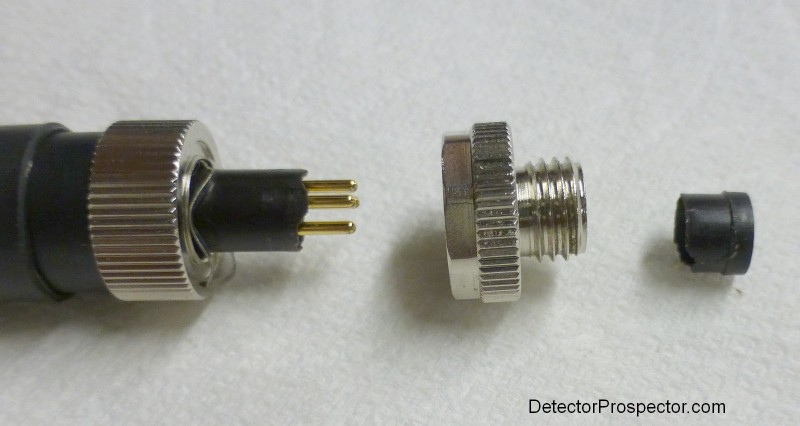
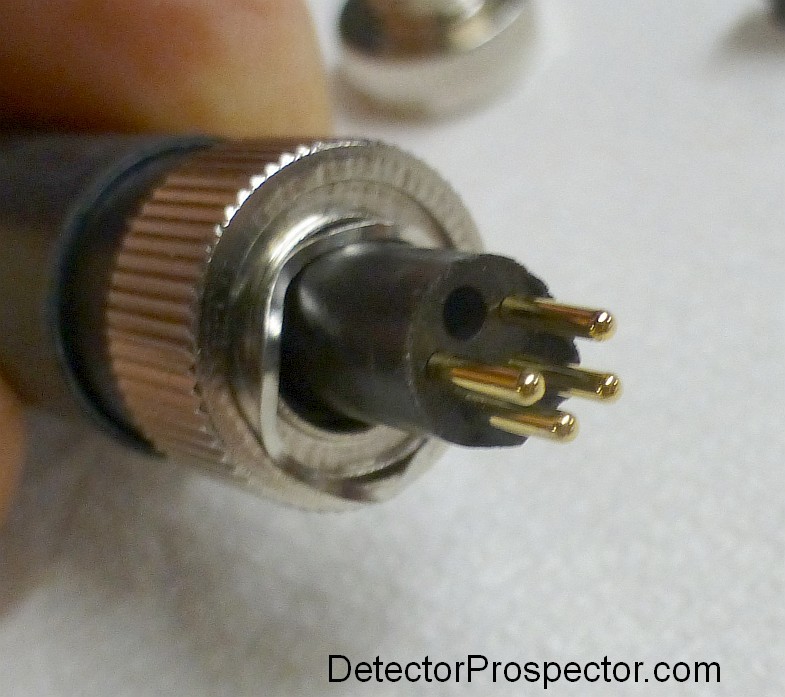
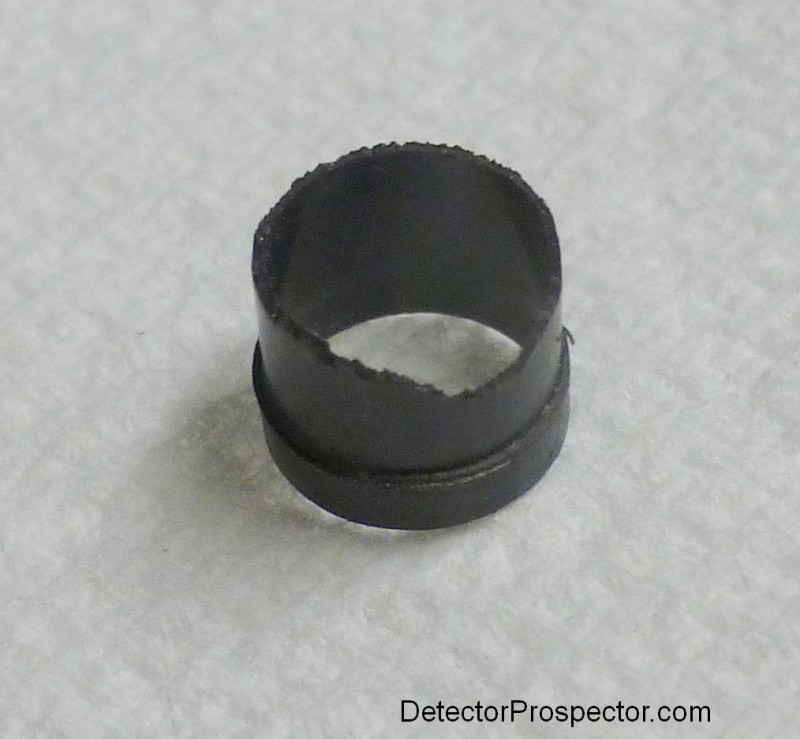
.thumb.jpg.d71314a45f3dc82bf75ac1b96e7e9201.jpg)
